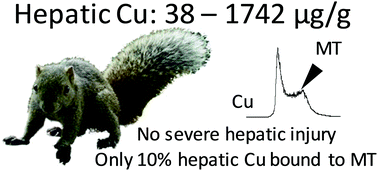Changes in copper, zinc and cadmium distributions in the liver of Formosan squirrels with characteristic high copper accumulation†
Abstract
We discovered previously that Formosan squirrels (Callosciurus erythraeus) accumulate copper (Cu) in their livers at levels averaging 1700 μg per dry g (approximately 420 μg per wet g). In the current study, we investigated the relationship between Cu accumulation and hepatic injury, and we determined the distribution and chemical form of Cu in the liver supernatant. In particular, we explored the role of metallothionein in the liver supernatant. We observed no significant differences in hepatic Cu concentration between squirrels that showed pathological changes in the liver and those that did not. Serum alanine aminotransferase activity did not increase with increasing hepatic Cu concentration. These results suggest that abnormal Cu accumulation in the livers of Formosan squirrels does not induce severe hepatic injury. We found that 26.7% of the Cu in the liver was distributed to the supernatant, and only 11.0% of the Cu in the liver was bound to metallothionein, suggesting that metallothionein in the hepatic supernatant does not contribute to detoxification of excess Cu in Formosan squirrels.



 Please wait while we load your content...
Please wait while we load your content...